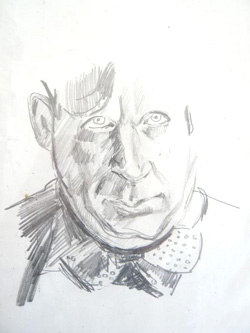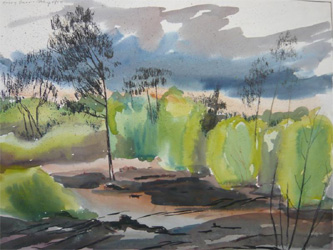
Harry Barr, 1896-1987
 Self-portrait, pencil
Self-portrait, pencil
Harry Barr was born in London in 1896, the grandson of Russian emigrants to England. After a very humble childhood in Whitechapel, he trained as a teacher, specializing in advanced drawing and chemistry. In the First World War, he volunteered for the Royal Flying Corps but was invalided out of the service.
He gained his Art Teacher's diploma in 1915 and studied for three years at the Westminster Art School with the distinguished artist, Walter Sickert. With Sickert he studied drawing and Walter Sickert remained a mentor and friend for life.
His first exhibition of line drawings was held at a Bloomsbury Gallery in January 1920. The following month he went to Paris, where he was befriended by the sculptor, Ossip Zadkine, who helped him find a studio. In June 1920, his oil paintings were exhibited at the Galerie Mouninou on the Rue Marbeuf, off the Champs Elysee. In 1923 he married his wife Anna, who like Harry Barr, was a child of Russian emigrants. They made their home in London.
In the depression years of the 1930s he trained as a physical training instructor and acted as a liaison officer for a group of hosiery importers. This work took him on frequent trips to Chemnitz in Germany and Lodz in Poland.
Although he had used watercolor for the preliminary sketches for his oil paintings, he started in 1939 to use watercolor as his main medium, finding in it a vitality and spontaneity lacking in other media. Always close to nature, whenever possible he worked out of doors, in all weathers, winter and summer, catching in his paintings the various moods of nature.
In the war years, he was limited by travel difficulties to the area around London, but after the war ended, he and his wife made frequent visits to Scotland, to Cornwall and East Anglia. East Anglia, in particular, attracted him and awoke in him the same intense feelings as those of the late 18th and early 19th century watercolorists many of whom came from or worked in East Anglia.
 Black Wisley, watercolour, 1950. Shown Moscow, 1965 and Leningrad, 1966
Black Wisley, watercolour, 1950. Shown Moscow, 1965 and Leningrad, 1966
In the spring of 1965 an exhibition of 120 of his watercolors was held at the Kaplan Gallery in London. Simultaneously an historic exhibition of 80 of his works was held at Friendship House in Moscow-he thus became the first British artist to have a one man show in the U.S.S.R. The exhibition was well received by the Russian press and public and its run was extended from two to six weeks. The exhibition was followed by a showing in Leningrad. In 1966, the shows were again presented in Moscow and Leningrad. Harry Barr was not able to go to Russia for these exhibitions. In 1966 he also exhibited at the Guildhall of St. George in King's Lynn, Norfolk, cementing further his links with this part of England. In 1968 he and his wife spent six weeks in Israel. Painting, as always, Harry Barr was fascinated by the very different light and the aridity, so different from England.
Harry Barr painted until the end of his long life, dying in 1987 at the age of 91. Old age had prevented him working out of doors but his last works retained the vitality of his earlier years.
Always a very private person, Harry Barr resisted pressure to join any of the English art movements. He always felt the urge to paint was latent in him and that, to him, it was a necessary job.
Max Wykes-Joycs, the art critic, wrote "My opinion, on record over and over again that the water colour, a specifically English medium is virtually dead. I am now forced to reverse that opinion, at least in the case of Harry Barr, whose work can be compared with the best of British watercolourists, past or present".